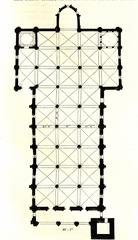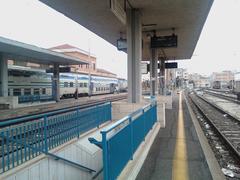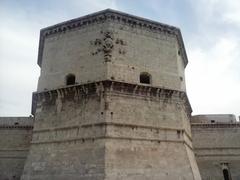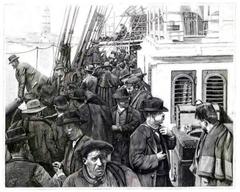Rocca di Civitavecchia Visiting Hours, Tickets, and Historical Sites Guide
Date: 14/06/2025
Introduction: Rocca di Civitavecchia and Its Legacy
The Rocca di Civitavecchia stands as an enduring testament to Italy’s maritime, architectural, and cultural heritage. Situated in the historic port city of Civitavecchia, this fortress traces its origins back to the Roman era, evolving through the medieval and Renaissance periods before weathering the conflicts of the modern age. Initially built to defend the ancient port of Centumcellae under Emperor Trajan, the Rocca played a pivotal role in safeguarding Rome’s coastal gateway, later becoming a prominent papal stronghold central to the city’s development and defense (Civitavecchia Port Authority website).
Today, visitors to the Rocca di Civitavecchia are invited to explore not just a structure, but the layered story of a city that has shaped—and been shaped by—centuries of conflict, commerce, and cultural exchange. With partially preserved walls, panoramic sea views, accessible tours, and proximity to key attractions like Fort Michelangelo and the Roman docks, the Rocca is an essential stop for history enthusiasts and curious travelers alike (Comune di Civitavecchia’s Forte Michelangelo page).
Contents
- Origins and Early Development
- Medieval Fortification and Feudal Control
- Renaissance Transformation and Architectural Highlights
- Strategic and Symbolic Significance
- The Rocca in the Modern Era
- Visiting the Rocca: Practical Information
- Visiting Hours
- Tickets and Admission
- Accessibility
- Guided Tours and Special Events
- Nearby Attractions
- Architectural Features and Evolution
- Medieval Foundations and Strategic Design
- Integration with Roman Heritage
- Papal and Renaissance Influence
- Wartime Destruction and Present Remains
- Cultural Significance
- Site Experience and Guided Tours
- Cultural and Historical Context
- Nearby Attractions and Suggested Itineraries
- Visual Highlights
- FAQ: Rocca di Civitavecchia Visiting Hours, Tickets, and More
- Contact Information
1. Origins and Early Development
The roots of the Rocca di Civitavecchia stretch back to the reign of Emperor Trajan (107–110 AD), when the ancient port of Centumcellae was constructed as a vital maritime hub for Rome. After the fall of the Western Roman Empire, the site remained strategically important, enduring periods of abandonment and rebuilding due to Saracen invasions. Over time, the city regained its prominence, with the Rocca growing alongside it (ermakvagus.com).
2. Medieval Fortification and Feudal Control
Documented as early as 1072, the Rocca was established atop the ruins of the ancient port. Throughout the Middle Ages, it was a contested power center, serving as both a military fortress and symbol of authority for local feudal lords and, eventually, the Papacy. In 1431, the last feudal lord surrendered after a papal siege, marking the end of feudal rule and cementing papal control (ermakvagus.com).
3. Renaissance Transformation and Architectural Highlights
The Renaissance brought significant restoration and expansion to the Rocca. Under papal direction, the city’s walls and infrastructure were improved, including the construction of an aqueduct. Pope Julius II commissioned Donato Bramante and Michelangelo Buonarroti to enhance the fortress, resulting in the imposing Fort Michelangelo that incorporated the medieval core and advanced Renaissance defensive features (cabroma.com).
4. Strategic and Symbolic Significance
During the 16th and 17th centuries, the Rocca and Fort Michelangelo were pivotal in the defense of the Papal States. The fortress was not only a military installation but also a symbol of papal authority and the city’s resilience against external threats. Key historical events, such as the housing of the Knights Hospitaller and papal blessings of fleets, underscored its strategic importance (ermakvagus.com).
5. The Rocca in the Modern Era
The Rocca continued to serve as a military and administrative hub through the centuries, enduring wars and bombings, notably during World War II. Despite severe damage, portions of the structure remain, offering valuable insights into military architecture and local history (cabroma.com).
6. Visiting the Rocca: Practical Information
Visiting Hours
- Tuesday to Sunday: 9:00 AM – 6:00 PM
- Closed: Mondays and major public holidays
- Note: Check the official website for seasonal variations or special event hours.
Tickets and Admission
- General Admission: Free for the open-air ruins; some restored sections and exhibitions may require tickets.
- Guided Tours: Fees may apply; advance booking recommended during peak seasons.
Accessibility
- Partial accessibility for visitors with mobility needs; some areas are uneven or include stairs.
- Contact the site in advance for assistance.
Guided Tours and Special Events
- Regular guided tours by expert historians.
- Special events such as cultural festivals and exhibitions are held throughout the year.
Nearby Attractions
- Fort Michelangelo: Renaissance fortress by the port.
- Darsena Romana: Ancient Roman dock.
- Museo Archeologico Nazionale: Regional archaeological museum.
- Vanvitelli Fountain: Elegant 18th-century fountain.
- Porta Livorno & Porta Marina: Historic city gates.
(Port Mobility; lovecivitavecchia.it; Comune di Civitavecchia)
7. Architectural Features and Evolution
Medieval Foundations and Strategic Design
The Rocca was constructed to bolster the city’s defensive walls, rising vertically above the Roman dock to maximize strategic advantage. Its compact, cubic form and thick stone walls epitomize late medieval military architecture.
Integration with Roman Heritage
The fortress’s lower courses incorporate ancient Roman blocks, physically linking the city’s medieval and classical past. This merging of eras is both practical and symbolic, reinforcing Civitavecchia’s identity as Rome’s maritime outpost.
Papal and Renaissance Influence
Renaissance renovations under papal patronage introduced decorative stonework, papal insignias, and more comfortable interiors, visible in the surviving sections of Fort Michelangelo.
Wartime Destruction and Present Remains
Much of the Rocca was destroyed during World War II bombings. Today, the base and portions near the Roman dock survive, offering insight into medieval and Roman construction.
(Port Mobility; Roma Experience)
8. Cultural Significance
Symbol of Civic Identity and Continuity
Visible to arriving ships, the Rocca has long symbolized Civitavecchia’s resilience and its status as Rome’s gateway to the sea. Its layered architecture reflects the city’s multicultural history.
Center of Historical Events
The Rocca was the focal point of power struggles, papal campaigns, and local celebrations, shaping Civitavecchia’s urban and social fabric.
Urban Influence
The fortress influenced the city’s development, with streets and public spaces radiating from its walls and nearby Roman dock.
(Port Mobility; Roma Experience)
9. Site Experience and Guided Tours
Visitors may explore the evocative ruins at leisure, with interpretive signage providing historical context. Guided tours are available through local tourism offices and independent guides, often including nearby sites for a comprehensive historical experience (lovecivitavecchia.it).
10. Cultural and Historical Context
The Rocca’s history mirrors the broader story of Civitavecchia—from Roman harbor to papal stronghold to a modern port city. Its silhouette remains central in local traditions, festivals, and the collective memory of resilience and adaptation (lovecivitavecchia.it).
11. Nearby Attractions and Suggested Itineraries
- Museo Archeologico Nazionale: Etruscan, Roman, and medieval artifacts.
- Cattedrale di San Francesco: Rebuilt after World War II.
- Terme Taurine: Roman baths on the city’s outskirts.
- Porto Antico: Historic port area with Roman and Renaissance features.
Suggested walking route: Start at the Rocca, stroll through the historic center, and finish at the waterfront for local cuisine and sea views (trip101.com).
12. Visual Highlights
The fortress offers panoramic sea views, particularly striking at sunset. Explore virtual tours and photo galleries via the official Port Mobility and municipal websites for inspiration and trip planning.
13. FAQ: Rocca di Civitavecchia Visiting Hours, Tickets, and More
Q: What are the Rocca di Civitavecchia visiting hours?
A: Typically 9:00 AM to 6:00 PM Tuesday–Sunday; closed Mondays.
Q: Is there an admission fee?
A: The open-air ruins are free to visit; exhibitions and guided tours may require tickets.
Q: Is the site wheelchair accessible?
A: There is partial accessibility. Some uneven terrain—check ahead for assistance.
Q: Are guided tours available in English?
A: Some tours are available in English, especially during major events.
Q: What is the best time to visit?
A: Spring and autumn for mild weather; late afternoon for photography.
14. Contact Information
- Address: Piazzale Pietro Guglielmotti, 7 – 00053 Civitavecchia, RM
- Phone: +39 0766 5901
- Official Website: Comune di Civitavecchia
- Tourism Info: lovecivitavecchia.it
Visitor Recommendations and Final Tips
The Rocca di Civitavecchia encapsulates the city’s resilience and historical significance. Its ruins and surviving structures offer a powerful connection to centuries of maritime defense, papal authority, and urban development. Free public access, rich historical context, and proximity to other key sites make it an essential part of any Civitavecchia itinerary.
Enhance your experience with guided tours, check for special events, and use official resources like the Port Mobility guide and Comune di Civitavecchia website for up-to-date visiting hours and event listings. For curated walking tours and real-time updates, consider downloading the Audiala app.
Sources and Further Reading
- Visiting the Rocca di Civitavecchia: History, Tickets, Hours & Travel Tips for Exploring Civitavecchia Historical Sites (ermakvagus.com)
- Rocca di Civitavecchia: Visiting Hours, Tickets, and Architectural & Cultural Significance (Port Mobility)
- Civitavecchia: The City Port (Roma Experience)
- Rocca di Civitavecchia Visiting Hours, Tickets, and Guide to Civitavecchia Historical Sites (lovecivitavecchia.it)
- Things to Do in Civitavecchia (trip101.com)
- Forte Michelangelo (Comune di Civitavecchia)
- Cartoline da Civitavecchia Exhibition (Etruria News)
- What to See in Civitavecchia Through History and Nature (cabroma.com)





